Abstract
1. Two concentration-dependent effects of the muscarinic agonist carbachol (CCh) were characterized in submerged slices of rat hippocampus using extracellular recordings of excitatory postsynaptic potentials (EPSPs): muscarinic long-term potentiation (LTP(m)) and depression. 2. LTP(m) of the EPSP slope was seen following long exposure (20 min) of the slice to low concentrations of CCh (0.2-0.5 microM). This LTP(m) was not accompanied by a change in the size of the afferent fibre volley or by a change in paired-pulse potentiation, consistent with a postsynaptic locus of CCh action. 3. Intracellular recordings from voltage-clamped neurons of inward current evoked by iontophoretically applied alpha-amino-3-hydroxy-5-methyl-4-isoxazolepropionate (AMPA) and N-methyl-D-aspartate (NMDA) revealed that, while cellular responses to NMDA rose transiently upon superfusion with 0.5 microM CCh, responses to AMPA increased gradually and remained potentiated after washout of CCh. 4. LTP(m) is mediated by an M2 muscarinic receptor. Two M2 muscarinic receptor antagonists, methoctramine and AFDX-116, blocked LTP(m). The M2 agonist oxotremorine induced LTP(m) at low agonist concentrations. None of the M1 and M3 receptor agonists and antagonists tested affected LTP(m). 5. Muscarinic fast onset depression of the EPSP was seen in response to higher concentrations of CCh (2-5 mu M). This depression was accompanied by an increase in paired-pulse potentiation, indicating a possible presynaptic locus of action. The M3 muscarinic receptor antagonist 4-diphenylacetoxy-N-methylpiperidine methiodide (4-DAMP) blocked the muscarinic depression of the EPSP slope. M1, M2 and M4 muscarinic antagonists did not block this response. 6. Blockade of the muscarinic depression by 4-DAMP did not uncover a suppressed LTP(m). However, addition of picrotoxin facilitated the expression of LTP(m) induced by high concentrations of CCh, indicating an involvement of interneurons in regulation of LTP(m). 7. Cholinergic denervation produced by fimbria-fornix transection resulted in supersensitivity of both M2- and M3-mediated effects, indicating that the receptors mediating these effects are not located on presynaptic cholinergic fibres. In the presence of 4-DAMP and picrotoxin the dose-response curve for CCh-induced effects in slices from lesioned animals was shifted to the left relative to that of normal animals, indicating a supersensitivity of both receptor types.
Full text
PDF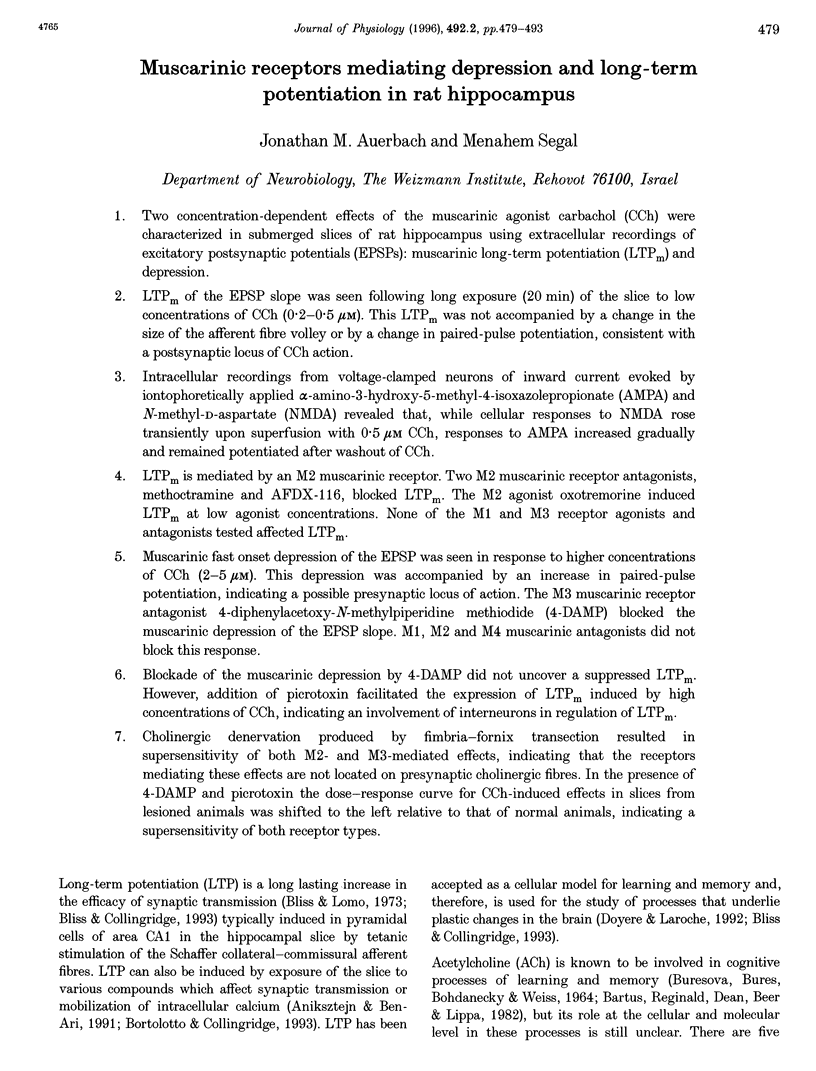
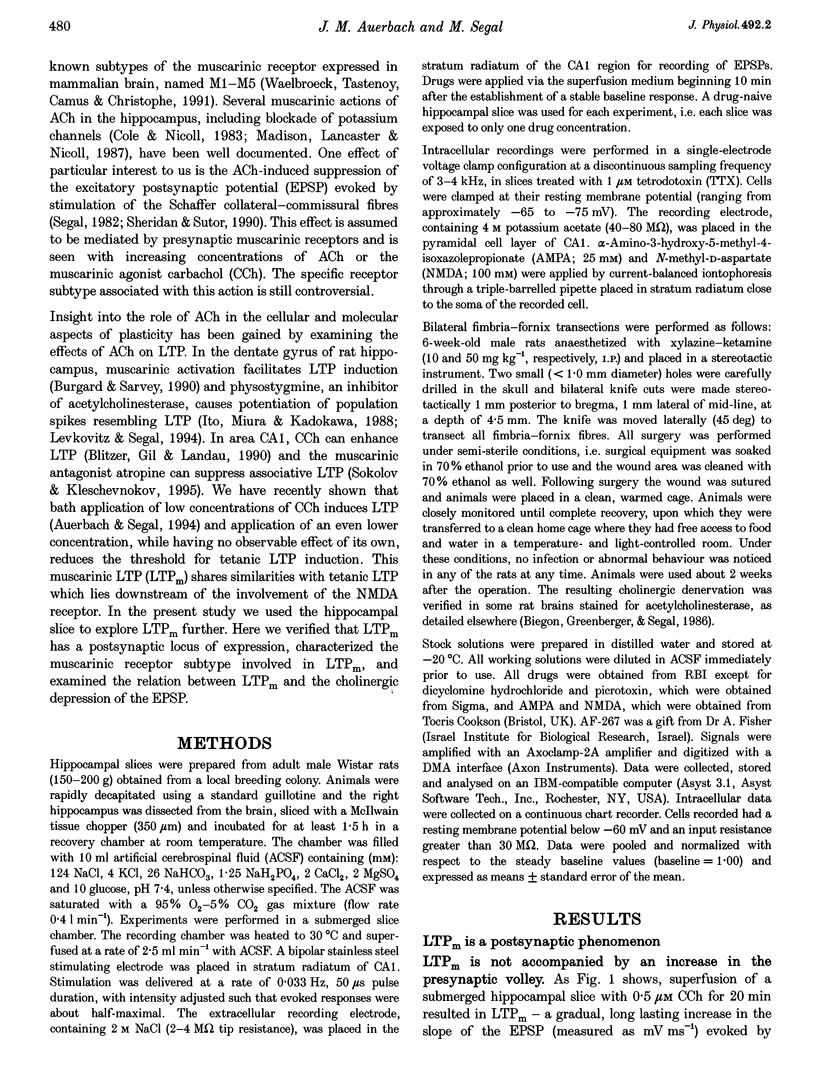

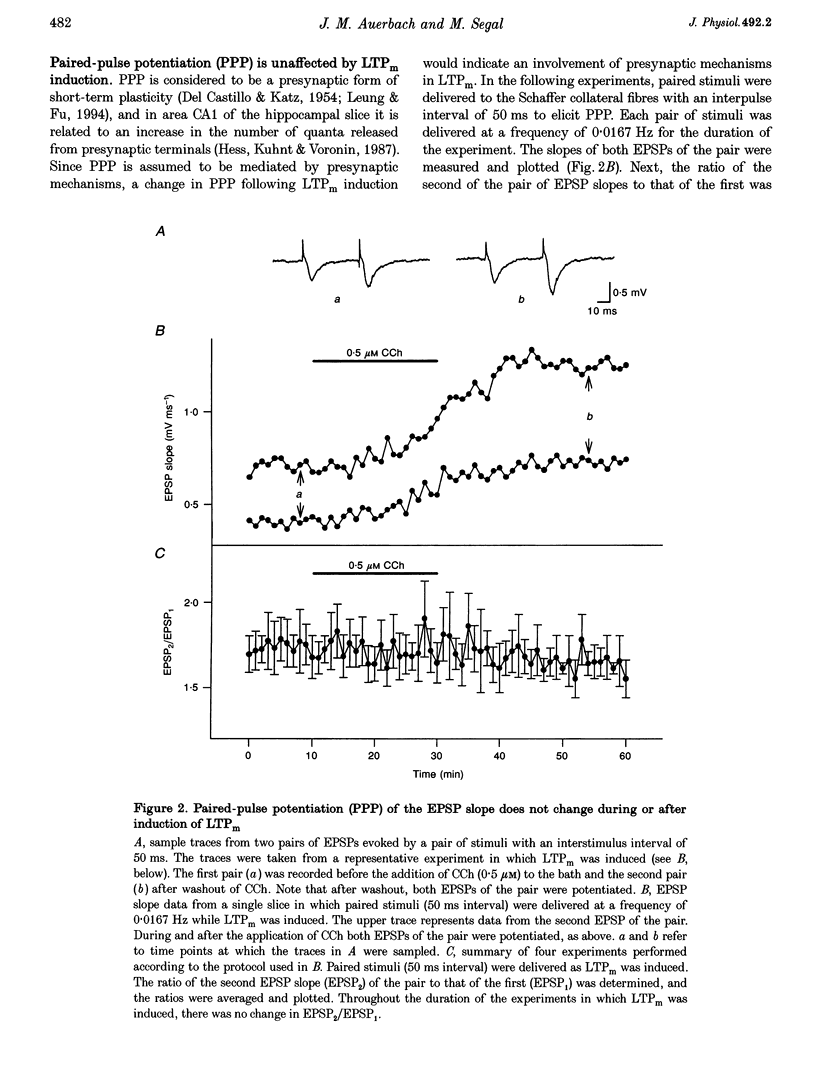
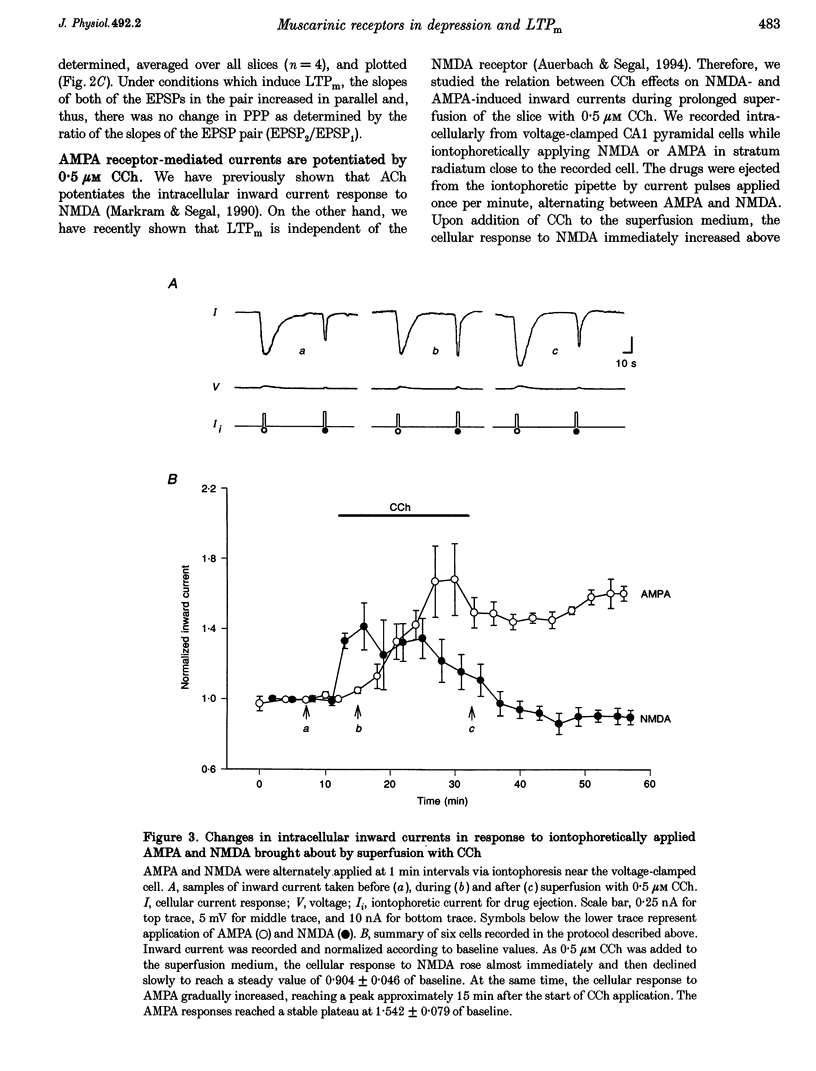
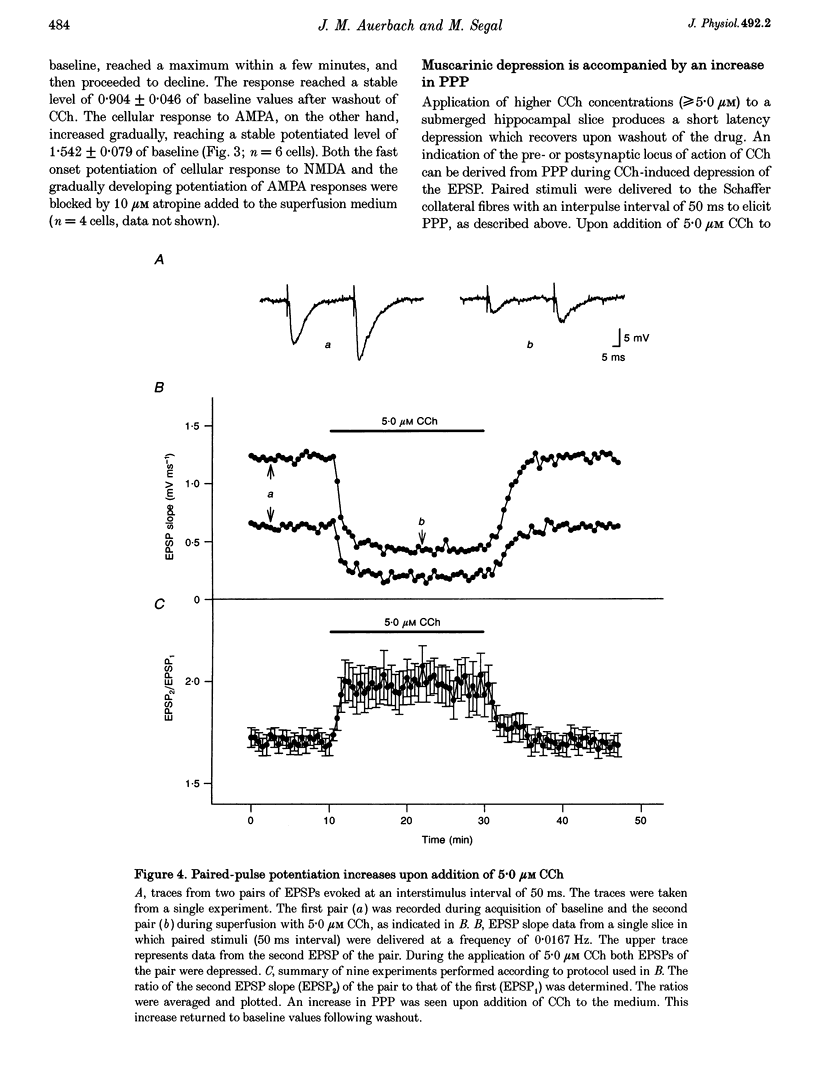
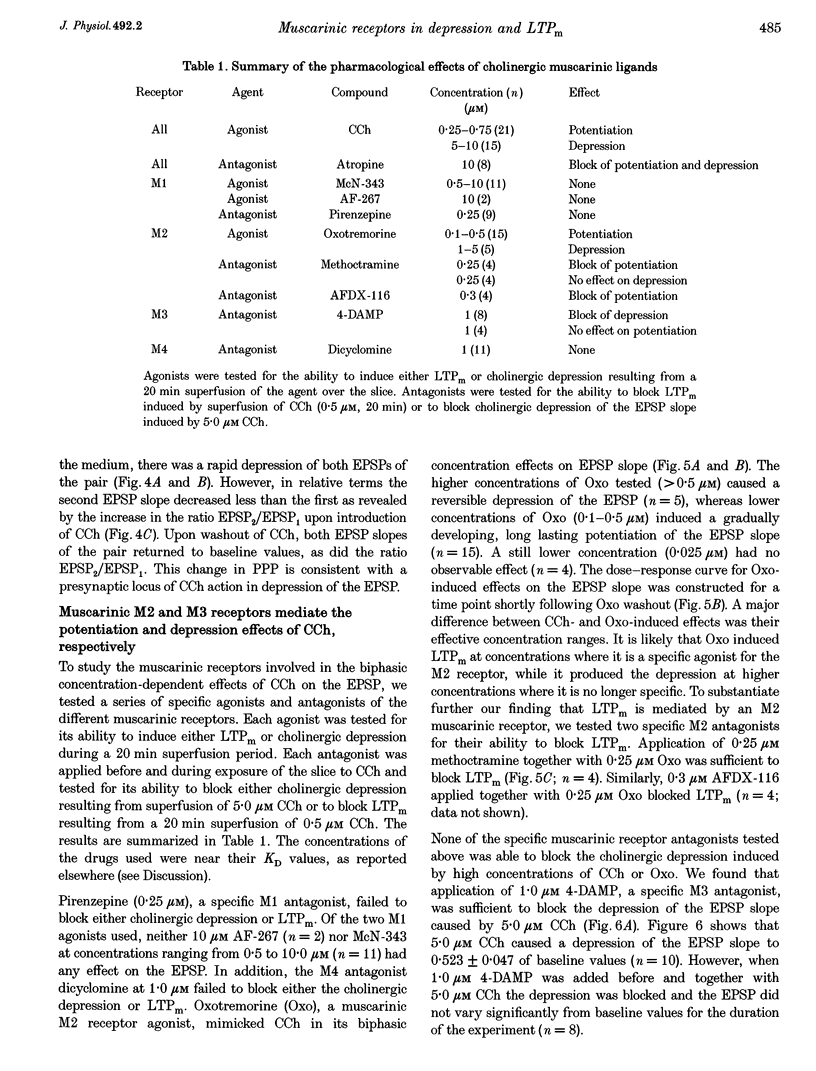
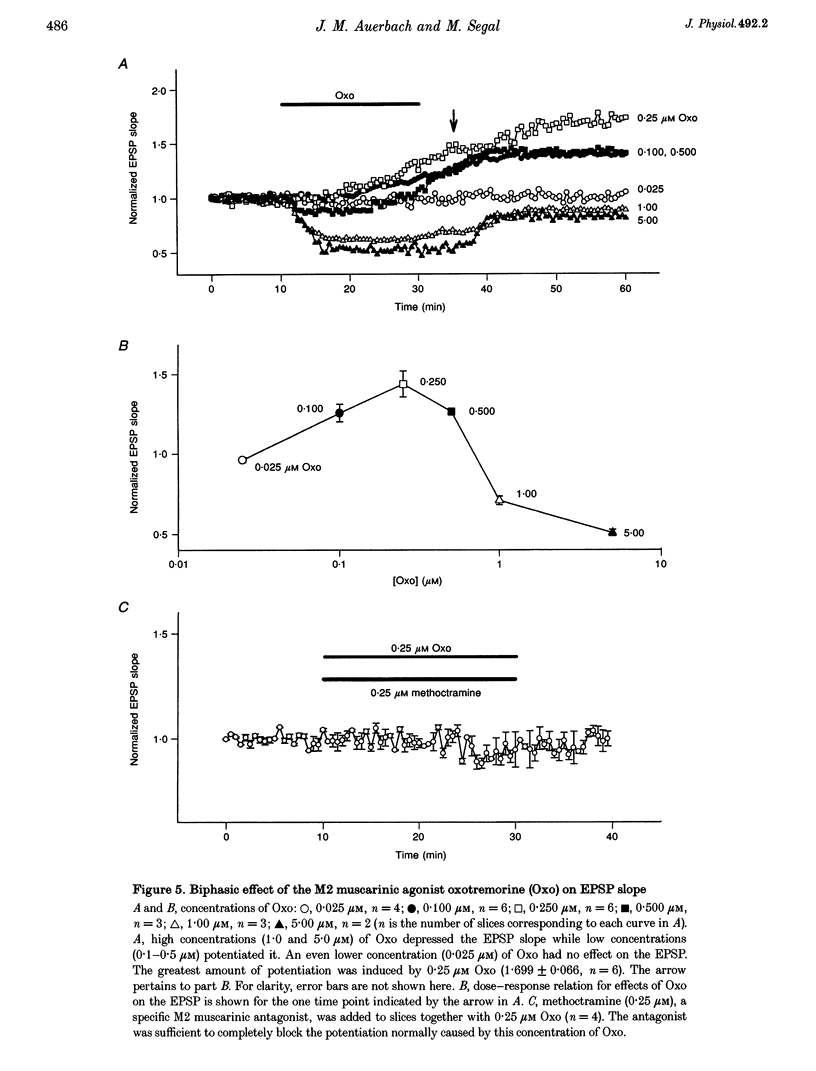
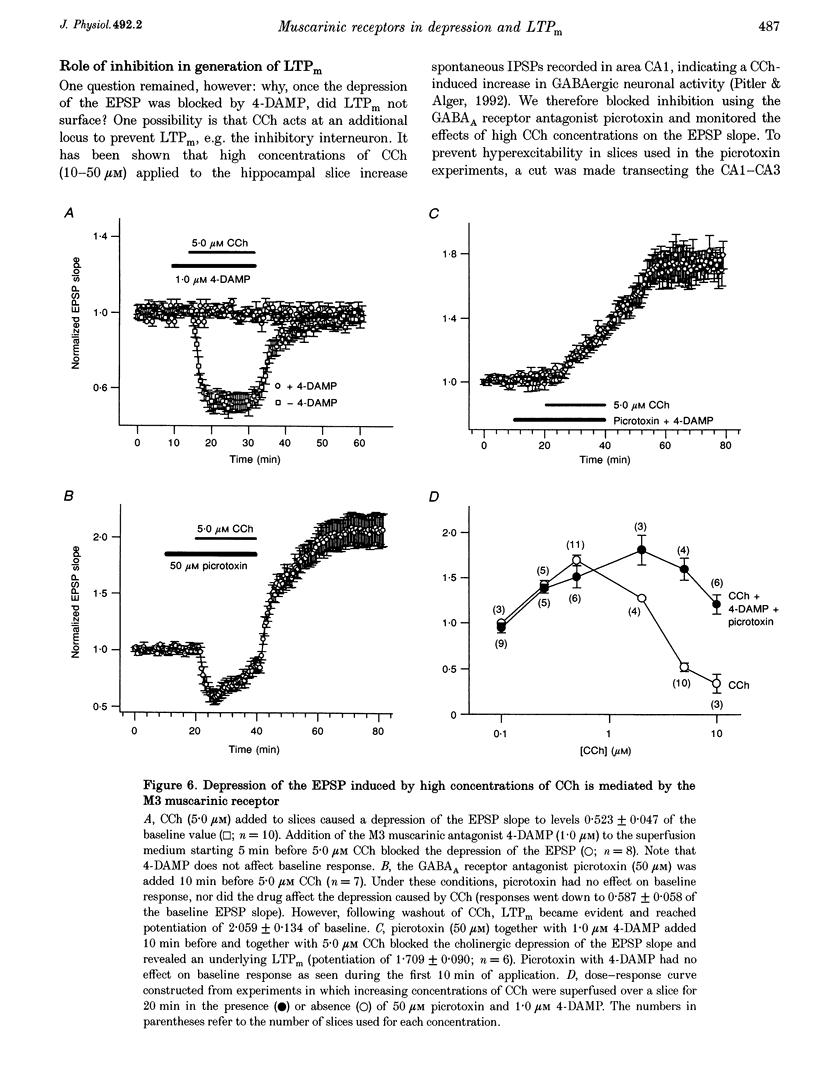
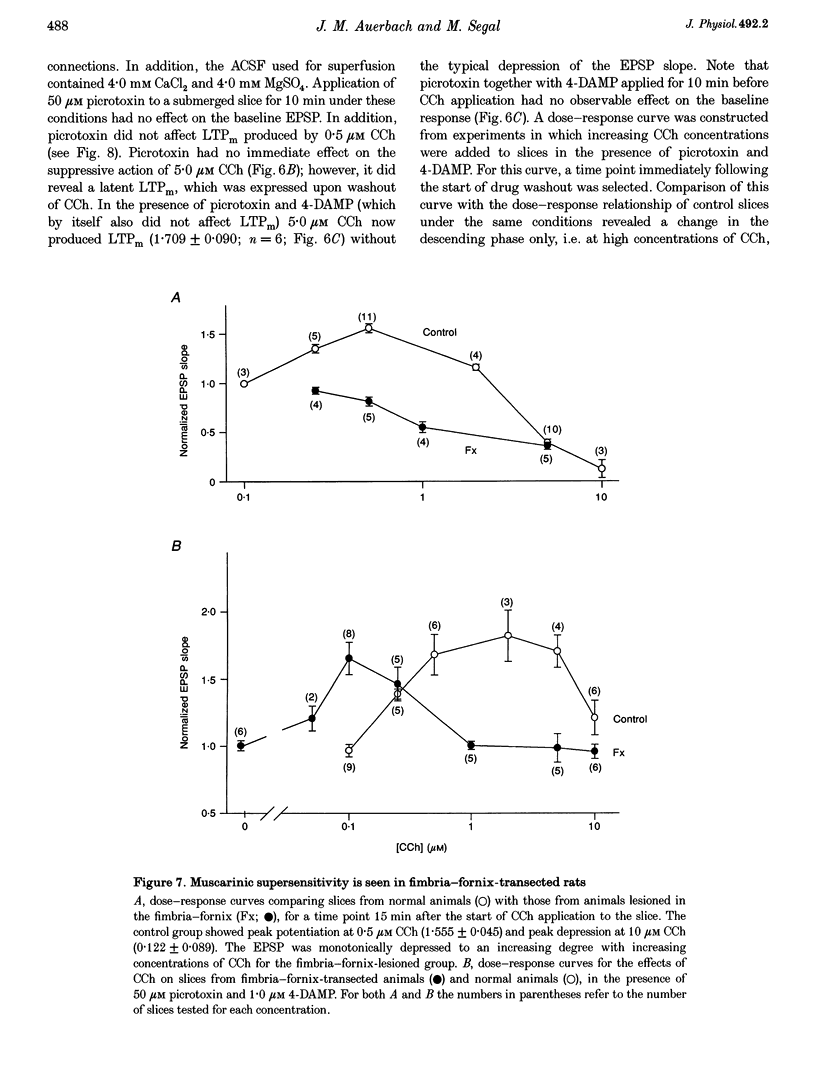
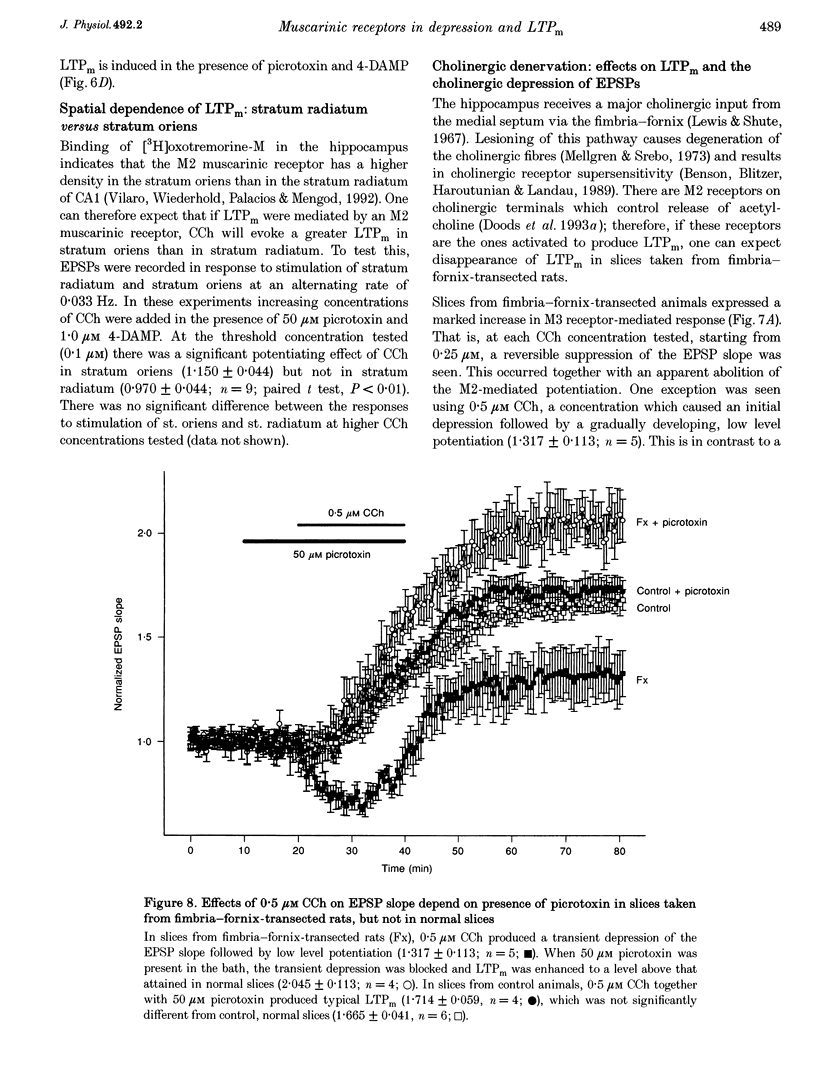
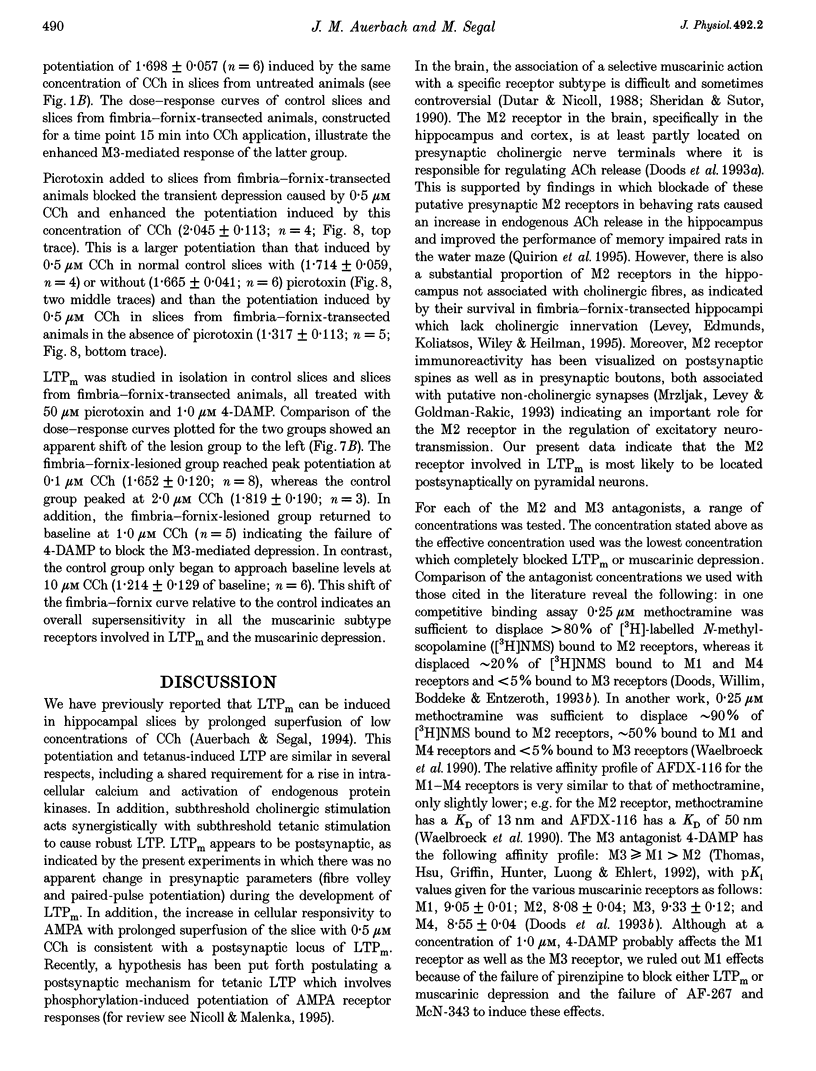
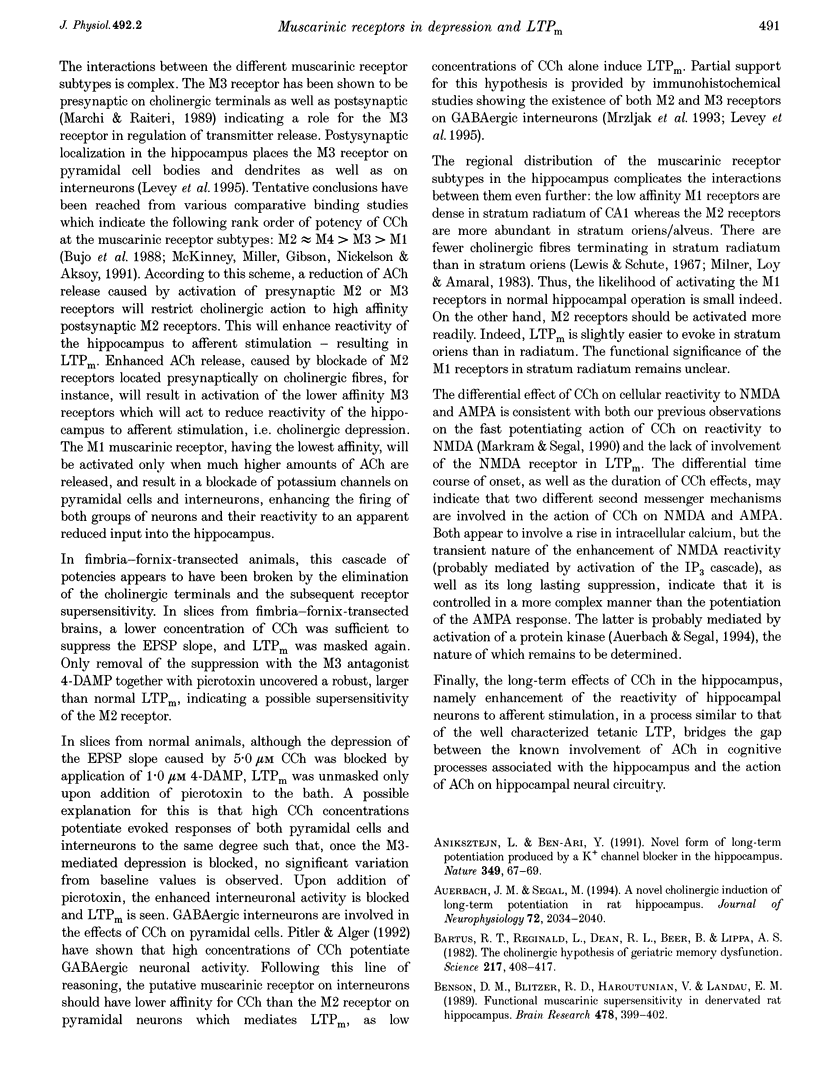
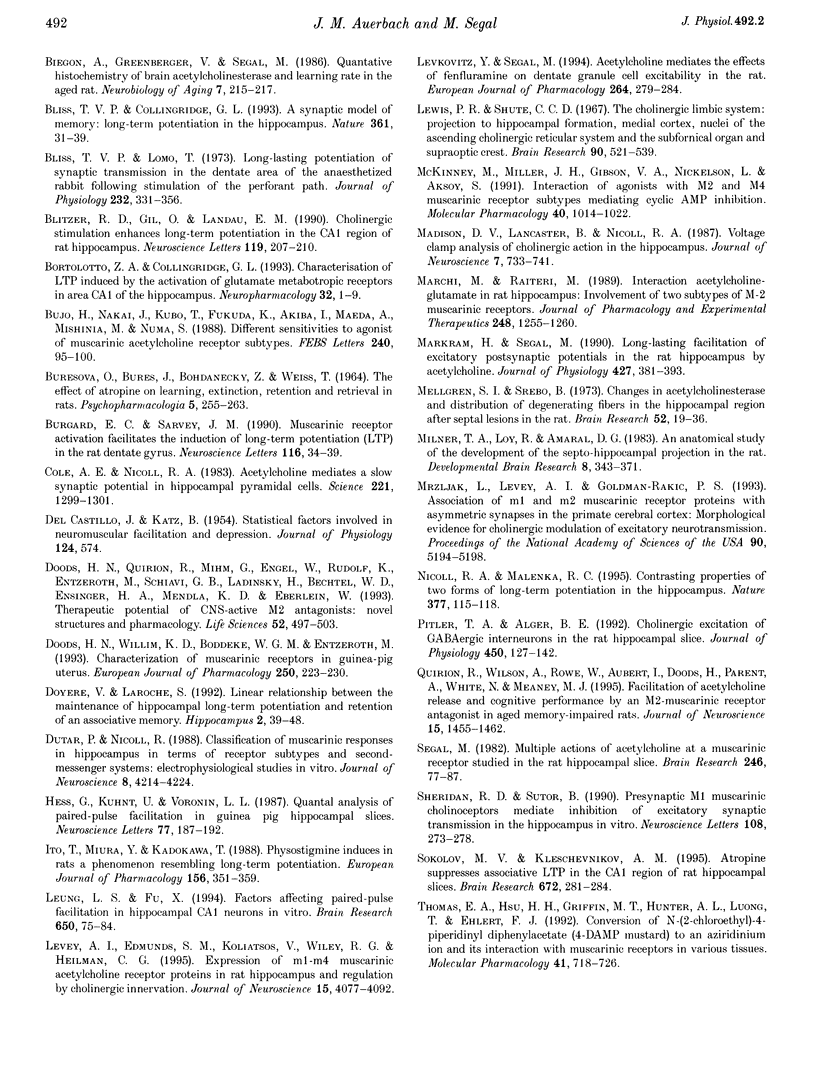
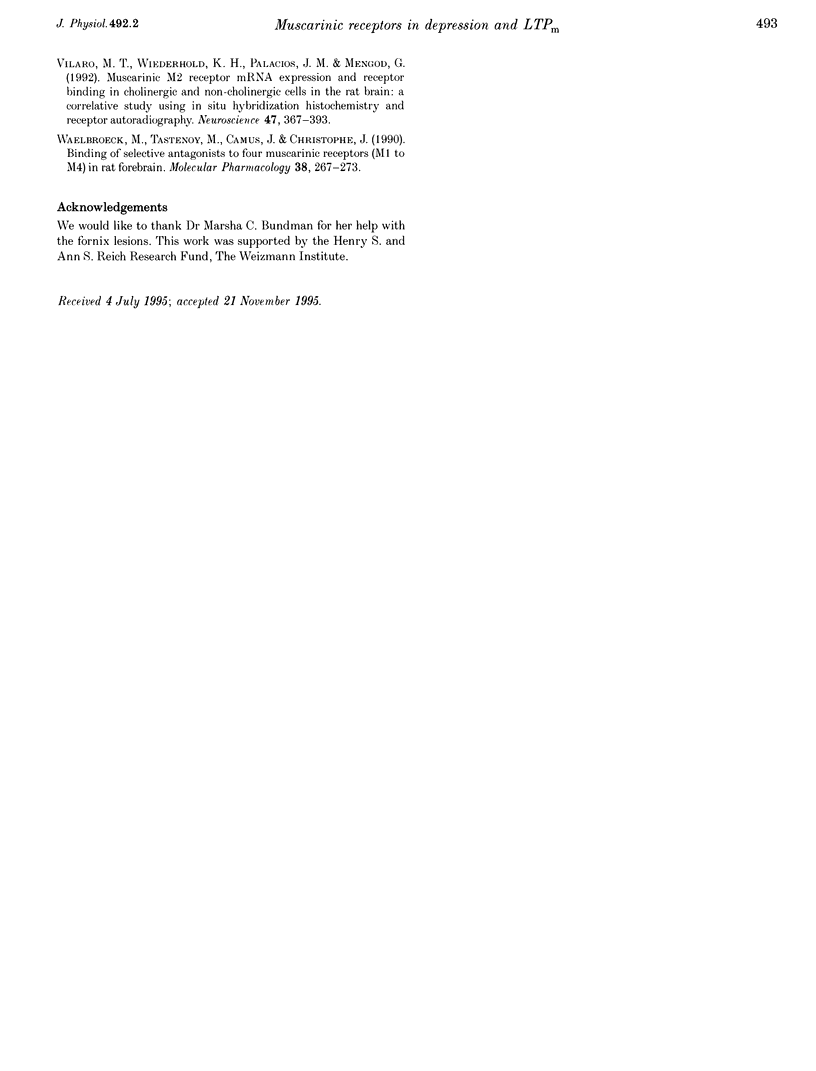
Selected References
These references are in PubMed. This may not be the complete list of references from this article.
- Aniksztejn L., Ben-Ari Y. Novel form of long-term potentiation produced by a K+ channel blocker in the hippocampus. Nature. 1991 Jan 3;349(6304):67–69. doi: 10.1038/349067a0. [DOI] [PubMed] [Google Scholar]
- Auerbach J. M., Segal M. A novel cholinergic induction of long-term potentiation in rat hippocampus. J Neurophysiol. 1994 Oct;72(4):2034–2040. doi: 10.1152/jn.1994.72.4.2034. [DOI] [PubMed] [Google Scholar]
- BURESOVA O., BURES J., BOHDANECKY Z., WEISS T. EFFECT OF ATROPINE ON LEARNING, EXTINCTION, RETENTION AND RETRIEVAL IN RATS. Psychopharmacologia. 1964 Mar 11;5:255–263. doi: 10.1007/BF02341258. [DOI] [PubMed] [Google Scholar]
- Bartus R. T., Dean R. L., 3rd, Beer B., Lippa A. S. The cholinergic hypothesis of geriatric memory dysfunction. Science. 1982 Jul 30;217(4558):408–414. doi: 10.1126/science.7046051. [DOI] [PubMed] [Google Scholar]
- Benson D. M., Blitzer R. D., Haroutunian V., Landau E. M. Functional muscarinic supersensitivity in denervated rat hippocampus. Brain Res. 1989 Jan 30;478(2):399–402. doi: 10.1016/0006-8993(89)91524-2. [DOI] [PubMed] [Google Scholar]
- Biegon A., Greenberger V., Segal M. Quantitative histochemistry of brain acetylcholinesterase and learning rate in the aged rat. Neurobiol Aging. 1986 May-Jun;7(3):215–217. doi: 10.1016/0197-4580(86)90046-1. [DOI] [PubMed] [Google Scholar]
- Bliss T. V., Collingridge G. L. A synaptic model of memory: long-term potentiation in the hippocampus. Nature. 1993 Jan 7;361(6407):31–39. doi: 10.1038/361031a0. [DOI] [PubMed] [Google Scholar]
- Bliss T. V., Lomo T. Long-lasting potentiation of synaptic transmission in the dentate area of the anaesthetized rabbit following stimulation of the perforant path. J Physiol. 1973 Jul;232(2):331–356. doi: 10.1113/jphysiol.1973.sp010273. [DOI] [PMC free article] [PubMed] [Google Scholar]
- Blitzer R. D., Gil O., Landau E. M. Cholinergic stimulation enhances long-term potentiation in the CA1 region of rat hippocampus. Neurosci Lett. 1990 Nov 13;119(2):207–210. doi: 10.1016/0304-3940(90)90835-w. [DOI] [PubMed] [Google Scholar]
- Bortolotto Z. A., Collingridge G. L. Characterisation of LTP induced by the activation of glutamate metabotropic receptors in area CA1 of the hippocampus. Neuropharmacology. 1993 Jan;32(1):1–9. doi: 10.1016/0028-3908(93)90123-k. [DOI] [PubMed] [Google Scholar]
- Bujo H., Nakai J., Kubo T., Fukuda K., Akiba I., Maeda A., Mishina M., Numa S. Different sensitivities to agonist of muscarinic acetylcholine receptor subtypes. FEBS Lett. 1988 Nov 21;240(1-2):95–100. doi: 10.1016/0014-5793(88)80346-6. [DOI] [PubMed] [Google Scholar]
- Burgard E. C., Sarvey J. M. Muscarinic receptor activation facilitates the induction of long-term potentiation (LTP) in the rat dentate gyrus. Neurosci Lett. 1990 Aug 14;116(1-2):34–39. doi: 10.1016/0304-3940(90)90382-j. [DOI] [PubMed] [Google Scholar]
- Cole A. E., Nicoll R. A. Acetylcholine mediates a slow synaptic potential in hippocampal pyramidal cells. Science. 1983 Sep 23;221(4617):1299–1301. doi: 10.1126/science.6612345. [DOI] [PubMed] [Google Scholar]
- DEL CASTILLO J., KATZ B. Statistical factors involved in neuromuscular facilitation and depression. J Physiol. 1954 Jun 28;124(3):574–585. doi: 10.1113/jphysiol.1954.sp005130. [DOI] [PMC free article] [PubMed] [Google Scholar]
- Doods H. N., Quirion R., Mihm G., Engel W., Rudolf K., Entzeroth M., Schiavi G. B., Ladinsky H., Bechtel W. D., Ensinger H. A. Therapeutic potential of CNS-active M2 antagonists: novel structures and pharmacology. Life Sci. 1993;52(5-6):497–503. doi: 10.1016/0024-3205(93)90307-o. [DOI] [PubMed] [Google Scholar]
- Doods H. N., Willim K. D., Boddeke H. W., Entzeroth M. Characterization of muscarinic receptors in guinea-pig uterus. Eur J Pharmacol. 1993 Dec 7;250(2):223–230. doi: 10.1016/0014-2999(93)90385-u. [DOI] [PubMed] [Google Scholar]
- Doyère V., Laroche S. Linear relationship between the maintenance of hippocampal long-term potentiation and retention of an associative memory. Hippocampus. 1992 Jan;2(1):39–48. doi: 10.1002/hipo.450020106. [DOI] [PubMed] [Google Scholar]
- Dutar P., Nicoll R. A. Classification of muscarinic responses in hippocampus in terms of receptor subtypes and second-messenger systems: electrophysiological studies in vitro. J Neurosci. 1988 Nov;8(11):4214–4224. doi: 10.1523/JNEUROSCI.08-11-04214.1988. [DOI] [PMC free article] [PubMed] [Google Scholar]
- Ito T., Miura Y., Kadokawa T. Physostigmine induces in rats a phenomenon resembling long-term potentiation. Eur J Pharmacol. 1988 Nov 8;156(3):351–359. doi: 10.1016/0014-2999(88)90280-4. [DOI] [PubMed] [Google Scholar]
- Leung L. S., Fu X. W. Factors affecting paired-pulse facilitation in hippocampal CA1 neurons in vitro. Brain Res. 1994 Jul 4;650(1):75–84. doi: 10.1016/0006-8993(94)90209-7. [DOI] [PubMed] [Google Scholar]
- Levey A. I., Edmunds S. M., Koliatsos V., Wiley R. G., Heilman C. J. Expression of m1-m4 muscarinic acetylcholine receptor proteins in rat hippocampus and regulation by cholinergic innervation. J Neurosci. 1995 May;15(5 Pt 2):4077–4092. doi: 10.1523/JNEUROSCI.15-05-04077.1995. [DOI] [PMC free article] [PubMed] [Google Scholar]
- Levkovitz Y., Segal M. Acetylcholine mediates the effects of fenfluramine on dentate granule cell excitability in the rat. Eur J Pharmacol. 1994 Nov 3;264(3):279–284. doi: 10.1016/0014-2999(94)00474-9. [DOI] [PubMed] [Google Scholar]
- Lewis P. R., Shute C. C. The cholinergic limbic system: projections to hippocampal formation, medial cortex, nuclei of the ascending cholinergic reticular system, and the subfornical organ and supra-optic crest. Brain. 1967 Sep;90(3):521–540. doi: 10.1093/brain/90.3.521. [DOI] [PubMed] [Google Scholar]
- Madison D. V., Lancaster B., Nicoll R. A. Voltage clamp analysis of cholinergic action in the hippocampus. J Neurosci. 1987 Mar;7(3):733–741. doi: 10.1523/JNEUROSCI.07-03-00733.1987. [DOI] [PMC free article] [PubMed] [Google Scholar]
- Marchi M., Raiteri M. Interaction acetylcholine-glutamate in rat hippocampus: involvement of two subtypes of M-2 muscarinic receptors. J Pharmacol Exp Ther. 1989 Mar;248(3):1255–1260. [PubMed] [Google Scholar]
- Markram H., Segal M. Long-lasting facilitation of excitatory postsynaptic potentials in the rat hippocampus by acetylcholine. J Physiol. 1990 Aug;427:381–393. doi: 10.1113/jphysiol.1990.sp018177. [DOI] [PMC free article] [PubMed] [Google Scholar]
- McKinney M., Miller J. H., Gibson V. A., Nickelson L., Aksoy S. Interactions of agonists with M2 and M4 muscarinic receptor subtypes mediating cyclic AMP inhibition. Mol Pharmacol. 1991 Dec;40(6):1014–1022. [PubMed] [Google Scholar]
- Pitler T. A., Alger B. E. Cholinergic excitation of GABAergic interneurons in the rat hippocampal slice. J Physiol. 1992 May;450:127–142. doi: 10.1113/jphysiol.1992.sp019119. [DOI] [PMC free article] [PubMed] [Google Scholar]
- Quirion R., Wilson A., Rowe W., Aubert I., Richard J., Doods H., Parent A., White N., Meaney M. J. Facilitation of acetylcholine release and cognitive performance by an M(2)-muscarinic receptor antagonist in aged memory-impaired. J Neurosci. 1995 Feb;15(2):1455–1462. doi: 10.1523/JNEUROSCI.15-02-01455.1995. [DOI] [PMC free article] [PubMed] [Google Scholar]
- Segal M. Multiple action of acetylcholine at a muscarinic receptor studied in the rat hippocampal slice. Brain Res. 1982 Aug 19;246(1):77–87. doi: 10.1016/0006-8993(82)90144-5. [DOI] [PubMed] [Google Scholar]
- Sheridan R. D., Sutor B. Presynaptic M1 muscarinic cholinoceptors mediate inhibition of excitatory synaptic transmission in the hippocampus in vitro. Neurosci Lett. 1990 Jan 22;108(3):273–278. doi: 10.1016/0304-3940(90)90653-q. [DOI] [PubMed] [Google Scholar]
- Sokolov M. V., Kleschevnikov A. M. Atropine suppresses associative LTP in the CA1 region of rat hippocampal slices. Brain Res. 1995 Feb 20;672(1-2):281–284. doi: 10.1016/0006-8993(94)01376-s. [DOI] [PubMed] [Google Scholar]
- Thomas E. A., Hsu H. H., Griffin M. T., Hunter A. L., Luong T., Ehlert F. J. Conversion of N-(2-chloroethyl)-4-piperidinyl diphenylacetate (4-DAMP mustard) to an aziridinium ion and its interaction with muscarinic receptors in various tissues. Mol Pharmacol. 1992 Apr;41(4):718–726. [PubMed] [Google Scholar]
- Vilaró M. T., Wiederhold K. H., Palacios J. M., Mengod G. Muscarinic M2 receptor mRNA expression and receptor binding in cholinergic and non-cholinergic cells in the rat brain: a correlative study using in situ hybridization histochemistry and receptor autoradiography. Neuroscience. 1992;47(2):367–393. doi: 10.1016/0306-4522(92)90253-x. [DOI] [PubMed] [Google Scholar]
- Waelbroeck M., Tastenoy M., Camus J., Christophe J. Binding of selective antagonists to four muscarinic receptors (M1 to M4) in rat forebrain. Mol Pharmacol. 1990 Aug;38(2):267–273. [PubMed] [Google Scholar]


